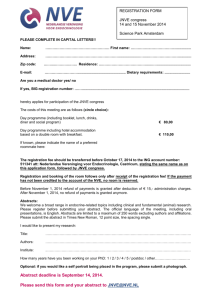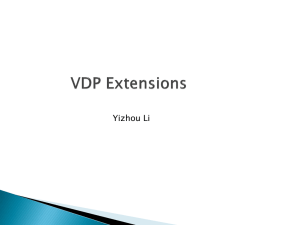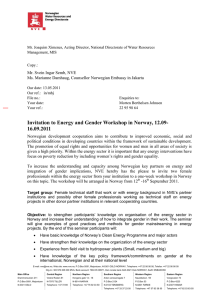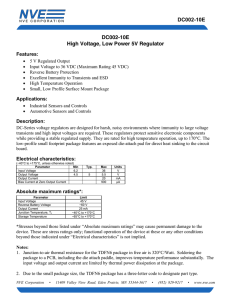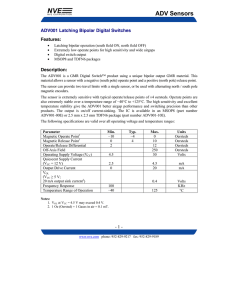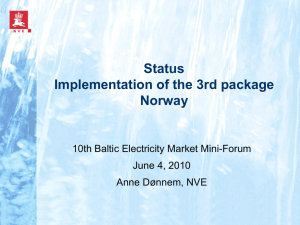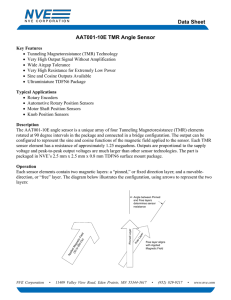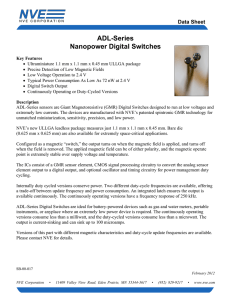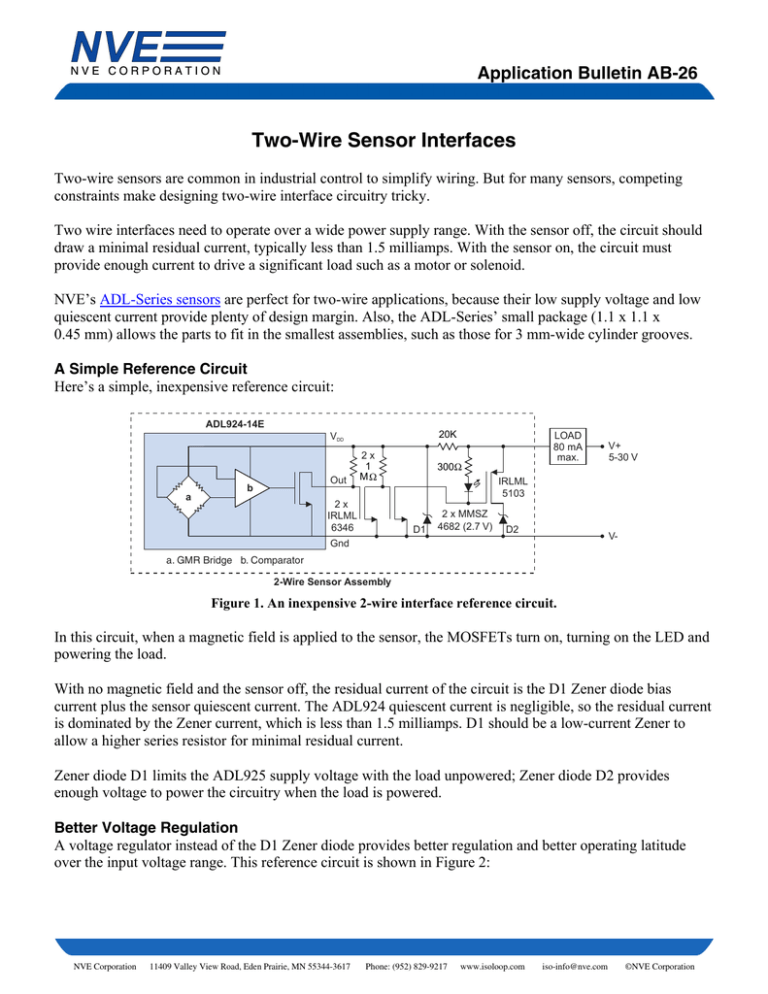
Application Bulletin AB-26
Two-Wire Sensor Interfaces
Two-wire sensors are common in industrial control to simplify wiring. But for many sensors, competing
constraints make designing two-wire interface circuitry tricky.
Two wire interfaces need to operate over a wide power supply range. With the sensor off, the circuit should
draw a minimal residual current, typically less than 1.5 milliamps. With the sensor on, the circuit must
provide enough current to drive a significant load such as a motor or solenoid.
NVE’s ADL-Series sensors are perfect for two-wire applications, because their low supply voltage and low
quiescent current provide plenty of design margin. Also, the ADL-Series’ small package (1.1 x 1.1 x
0.45 mm) allows the parts to fit in the smallest assemblies, such as those for 3 mm-wide cylinder grooves.
A Simple Reference Circuit
Here’s a simple, inexpensive reference circuit:
ADL924-14E
20K
VDD
a
Out
b
2x
1
M
2x
IRLML
6346
LOAD
80 mA
max.
300
V+
5-30 V
IRLML
5103
D1
2 x MMSZ
4682 (2.7 V)
D2
V-
Gnd
a. GMR Bridge b. Comparator
2-Wire Sensor Assembly
Figure 1. An inexpensive 2-wire interface reference circuit.
In this circuit, when a magnetic field is applied to the sensor, the MOSFETs turn on, turning on the LED and
powering the load.
With no magnetic field and the sensor off, the residual current of the circuit is the D1 Zener diode bias
current plus the sensor quiescent current. The ADL924 quiescent current is negligible, so the residual current
is dominated by the Zener current, which is less than 1.5 milliamps. D1 should be a low-current Zener to
allow a higher series resistor for minimal residual current.
Zener diode D1 limits the ADL925 supply voltage with the load unpowered; Zener diode D2 provides
enough voltage to power the circuitry when the load is powered.
Better Voltage Regulation
A voltage regulator instead of the D1 Zener diode provides better regulation and better operating latitude
over the input voltage range. This reference circuit is shown in Figure 2:
NVE Corporation
11409 Valley View Road, Eden Prairie, MN 55344-3617
Phone: (952) 829-9217
www.isoloop.com
iso-info@nve.com
©NVE Corporation
Application Bulletin AB-24
ADL924-14E
VDD
3.3 V
Out
a
DC
001-10
300
200K
V+
5-30 V
IRLML
5103
b
NC7S
14M5X
LOAD
80 mA
max.
IRLML
6346
MMSZ
4685
(3.6 V)
Gnd
V-
a. GMR Bridge b. Comparator
2-Wire Sensor Assembly
Figure 2. A simple 2-wire interface using a voltage regulator and a TinyLogic invertor.
The residual current is dominated by the regulator’s quiescent current, which is less than one milliamp and
relatively constant over input voltage.
The Figure 2 circuit also uses an invertor in place of one of the MOSFETs, which eliminates a resistor.
Circuit Characterization
Measured characteristics of the Figure 1 and Figure 2 reference circuits are summarized as follows:
Parameter
Min. Input Voltage (sensor on; RL = 100Ω)
Max. Input Voltage (sensor on; RL = 100Ω)
Residual Current (V+ = VMAX = 30 V)
Holding Current
Symbol
VMIN
VMAX
IQ
IH
Circuit
Figure 1
Figure 2
5 V
3.1 V
30 V
30 V
1.3 mA
0.6 mA
11 mA
11 mA
Where:
VMIN is the minimum input voltage for the assembly to operate, which means there is at least 2.4 volts for
to the ADL924 sensor, which is its minimum supply voltage. VMIN must typically be 5 volts or less.
VMAX = is the maximum input supply voltage, which is typically at least 24 volts. VMAX is limited by the
maximum voltage of the MOSFETs and component power dissipation, especially the D2 Zener diode
power dissipation.
IQ is the worst-case residual, or quiescent, current with the sensor off and the V+ supply at maximum.
This is typically in the one milliamp range.
IH is the holding current, which is the minimum current that must be sourced through the load with the
sensor ON to ensure the sensor will operate (i.e., 2.4 volts to the sensor). Holding current for industrial
control two-wire interfaces typically ranges from 3 mA to 20 mA.
Note that these are measured parameters, not worst-case specifications.
As shown in the table above, the Figure 1 reference circuit has a higher residual current than the Figure 2
circuit because of the Zener diode bias. The Figure 2 circuit has a lower minimum voltage with the better
2
NVE Corporation
11409 Valley View Road, Eden Prairie, MN 55344-3617
Phone: (952) 829-9217
www.nve.com
sensor-info@nve.com
©NVE Corporation
Application Bulletin AB-24
line regulation provided by the regulator. Lower dropout regulators can be used in place of the DC001-10 for
even lower minimum input voltages.
For these circuits, the holding current is dominated by the LED current, and can be reduced by reducing the
LED drive.
The output current versus input voltage for the Figure 1 reference circuit is shown below:
80
Load Current (mA)
70
60
50
40
30
20
10
0
0
5
10
15
V+
20
25
30
Figure 3. 2-wire interface reference circuit (Figure 1) output current versus input voltage; RL = 333Ω.
Conclusion—ADL924 Sensor Are Ideal for 2-Wire Interfaces
ADL-Series sensors are ideal for two-wire proximity sensors because of their small size, low supply voltage,
and low quiescent current.
In addition to their impressive electrical specifications, ADL-Series sensors feature precise magnetic operate
points. Standard ADL-Series magnetic operate points are 20±5, and 28±7 oersteds, with other ranges
available by special order.
Buy Online
3
NVE Corporation
11409 Valley View Road, Eden Prairie, MN 55344-3617
Phone: (952) 829-9217
www.nve.com
sensor-info@nve.com
©NVE Corporation
Application Bulletin AB-24
Limited Warranty and Liability
Information in this document is believed to be accurate and reliable. However, NVE does not give any representations or warranties, expressed or
implied, as to the accuracy or completeness of such information and shall have no liability for the consequences of use of such information.
In no event shall NVE be liable for any indirect, incidental, punitive, special or consequential damages (including, without limitation, lost profits,
lost savings, business interruption, costs related to the removal or replacement of any products or rework charges) whether or not such damages
are based on tort (including negligence), warranty, breach of contract or any other legal theory.
Right to Make Changes
NVE reserves the right to make changes to information published in this document including, without limitation, specifications and product
descriptions at any time and without notice. This document supersedes and replaces all information supplied prior to its publication.
Use in Life-Critical or Safety-Critical Applications
Unless NVE and a customer explicitly agree otherwise in writing, NVE products are not designed, authorized or warranted to be suitable for use
in life support, life-critical or safety-critical devices or equipment. NVE accepts no liability for inclusion or use of NVE products in such
applications and such inclusion or use is at the customer’s own risk. Should the customer use NVE products for such application whether
authorized by NVE or not, the customer shall indemnify and hold NVE harmless against all claims and damages.
Applications
Applications described in this datasheet are illustrative only. NVE makes no representation or warranty that such applications will be suitable for
the specified use without further testing or modification.
Customers are responsible for the design and operation of their applications and products using NVE products, and NVE accepts no liability for
any assistance with applications or customer product design. It is customer’s sole responsibility to determine whether the NVE product is suitable
and fit for the customer’s applications and products planned, as well as for the planned application and use of customer’s third party customers.
Customers should provide appropriate design and operating safeguards to minimize the risks associated with their applications and products.
NVE does not accept any liability related to any default, damage, costs or problem which is based on any weakness or default in the customer’s
applications or products, or the application or use by customer’s third party customers. The customer is responsible for all necessary testing for
the customer’s applications and products using NVE products in order to avoid a default of the applications and the products or of the application
or use by customer’s third party customers. NVE accepts no liability in this respect.
Limiting Values
Stress above one or more limiting values (as defined in the Absolute Maximum Ratings System of IEC 60134) will cause permanent damage to
the device. Limiting values are stress ratings only and operation of the device at these or any other conditions above those given in the
recommended operating conditions of the datasheet is not warranted. Constant or repeated exposure to limiting values will permanently and
irreversibly affect the quality and reliability of the device.
Terms and Conditions of Sale
In case an individual agreement is concluded only the terms and conditions of the respective agreement shall apply. NVE hereby expressly
objects to applying the customer’s general terms and conditions with regard to the purchase of NVE products by customer.
No Offer to Sell or License
Nothing in this document may be interpreted or construed as an offer to sell products that is open for acceptance or the grant, conveyance or
implication of any license under any copyrights, patents or other industrial or intellectual property rights.
Export Control
This document as well as the items described herein may be subject to export control regulations. Export might require a prior authorization from
national authorities.
Automotive Qualified Products
Unless the datasheet expressly states that a specific NVE product is automotive qualified, the product is not suitable for automotive use. It is
neither qualified nor tested in accordance with automotive testing or application requirements. NVE accepts no liability for inclusion or use of
non-automotive qualified products in automotive equipment or applications.
In the event that customer uses the product for design-in and use in automotive applications to automotive specifications and standards, customer
(a) shall use the product without NVE’s warranty of the product for such automotive applications, use and specifications, and (b) whenever
customer uses the product for automotive applications beyond NVE’s specifications such use shall be solely at customer’s own risk, and
(c) customer fully indemnifies NVE for any liability, damages or failed product claims resulting from customer design and use of the product for
automotive applications beyond NVE’s standard warranty and NVE’s product specifications.
4
NVE Corporation
11409 Valley View Road, Eden Prairie, MN 55344-3617
Phone: (952) 829-9217
www.nve.com
sensor-info@nve.com
©NVE Corporation
Application Bulletin AB-24
An ISO 9001 Certified Company
NVE Corporation
11409 Valley View Road
Eden Prairie, MN 55344-3617 USA
Telephone: (952) 829-9217
Fax: (952) 829-9189
www.nve.com
e-mail: sensor-info@nve.com
©NVE Corporation
All rights are reserved. Reproduction in whole or in part is prohibited without the prior written consent of the copyright owner.
SB-AP-26
October 2015
5
NVE Corporation
11409 Valley View Road, Eden Prairie, MN 55344-3617
Phone: (952) 829-9217
www.nve.com
sensor-info@nve.com
©NVE Corporation

